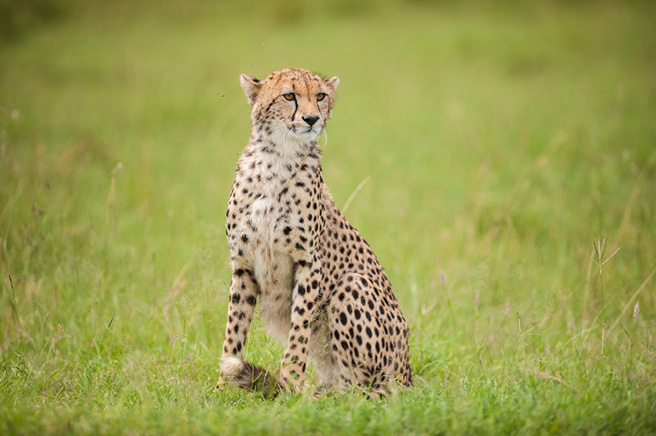Cheetahs: The World's Fastest Land Animal

I have to admit, I’m not usually a big fan of cats. But, for whatever reason, I cannot help but be captivated by cheetahs. Maybe it’s their grace and agility or maybe it’s just the face of a cheetah cub, but I think these cats are incredible.
Cheetahs are the world’s fastest land animal, capable of reaching speeds of up to 70 mph. Standing at about 30 inches tall at the shoulder and weighing between 110 and 140 pounds, they have long, graceful legs; a small, rounded head on a long neck; a very flexible spine; a deep chest; special pads on their feet that help with traction; and a long tail that is used for balance at top speed. The cheetah is also the only cat that cannot retract its claws, providing more traction. They also have distinctive black “tear tracks” that run from the corner of each eye to their mouth and provide anti-glare protection for daytime hunting.
In short, cheetahs are built for speed, grace, and hunting.
Cheetahs mainly prey on small antelopes such as Thomson’s gazelles and impalas, although they will also hunt small mammals and birds. When a cheetah hunts, it gets as close as possible to its prey before trying to outrun it with a burst of speed. The cheetah then uses its paw to swipe the animal to the ground and then suffocates it with a bite to the neck.
It then eats as quickly as possible while looking out for scavengers such as lions, leopards, hyenas, vultures, and jackals, who will steal from the very shy cheetah.
Unlike most other cats, cheetahs prefer to hunt during the day, particularly early morning or early evening.

Most of the time, cheetahs are solitary animals. On occasion, a male will hang out with a female after mating, but other than that, the female is either with her cubs or by herself.
Cubs spend a long time with their mothers as they learn to hunt. Mom will bring a small, live antelope back to her cubs so they can chase and catch it.
Unfortunately, there is a very high cub mortality rate among cheetahs. Approximately 50-75% die in the first three months of life because they are so susceptible to disease and predators such as eagles, hyenas, and lions.
Cheetahs are currently classified as “vulnerable” by the IUCN. In 1900, an estimated 100,000 cheetahs could be found across Africa. Now, there are about 7,500 adults left in the wild; the population has decreased by about 30% just in the past 18 years.
The high cub mortality rate is only one problem for cheetahs, though; they also face a lot of human-wildlife conflict and habitat loss.
Over the years, the cheetah’s habitat has shrunk dramatically, and it is now only 25% of its former size. Where they do live (mostly Eastern and Southern Africa), they tend to be found widely but sparsely.

Cheetahs live where their prey is: the open plains. However, as the human populations grow and people expand agriculture and civilization into the grassland, more and more of the cheetahs’ habitat is disappearing.
The other problem cheetahs are currently facing is human-wildlife conflict. As people expand into the cheetahs’ habitat, their usual prey is disappearing as well, forcing them to prey on livestock. This causes farmers to view them as pests and kill them in retaliation.
To help combat these problems, AWF is working to engage communities and minimize human-wildlife conflict.
By teaching communities that share space with cheetahs how to farm and expand sustainably and providing incentives for using the best practices, AWF is encouraging the people and animals are able to coexist peacefully. AWF is also helping to construct predator-proof bomas (livestock enclosures) to prevent the livestock from as much harm as possible. When cheetahs do kill livestock, farmers are given consolation funding so that they can replace the dead animal without having to seek revenge against the cheetahs.
In addition, AWF is also working to set aside land for conservation to ensure the cheetah will always have a place to live. When the Satao Elerai Lodge was opened in Kenya, the local Maasai community who owns the lodge agreed to set aside the surrounding area for conservation, and now the business and the land is thriving.
Also in Kenya, AWF is working with landowners in the Amboseli region to set aside land to create a wildlife corridor between Amboseli National Park and Chyulu Hills and Tsavo West National Park. By paying landowners for each acre set aside for wildlife, AWF is making sure that animals can continue to use their traditional routes without coming into harm’s way.
By working with the people who live side by side with cheetahs, we can help make sure these majestic creatures will be around for generations to come.
Explore our work caring for wildlife
All photos courtesy of Robyn Gianni.